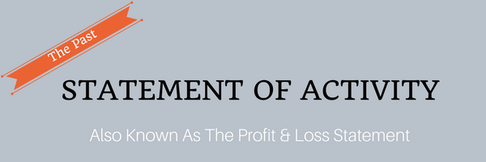|
When was the last time you heard a board member say this? “One of the most exciting things for me to do is to analyze financial reports.” Probably not very often, unless that board member is a bookkeeper or CPA. I’m not saying that everyone needs to LOVE pouring over the fine details of the organization’s finances, but I do believe if you know what to look for and how to read them, you will see how your finances tell an important story and will make you a more effective board member. Your financial statements tell a story that will ultimately guide your organization in making important decisions. There are three key financial reports that will help you understand the past, the present and the future. Think of this as your check register, broken down by categories that you’ve pre-determined, for a specific range of time that has past. It tells the story of where your money came from and what you spent it on. If you are like many board members I’ve worked with, you might be focusing on the wrong part of this report. The number one problem I see is when board members focus on the expense line items and pick them apart, while totally ignoring the revenue side. I believe this comes when people internalize organizational finances with their own. Think about when you look at your monthly income and expenses. Do you focus on how much money you made that month or do you look at how much you spent on eating out and think "wow, I have to watch my spending". The same thing happens in the board meeting. I have witnessed 30 minute conversations revolve around a $500 office expense (that you can’t do anything about because it’s in the past) instead of focusing on evaluating the revenue and making sure the sources are diversified. This isn’t to say looking at the expense line items isn’t important, but it’s not something to get hung up on. Once your board understands the significance of looking into the past and has the context to evaluate the numbers, they will stop wasting time on insignificant expense line items. The balance sheet is a snapshot of your organization’s financial position at a specific point in time. It shows what you own and what you owe in that exact moment. It tells the story of how healthy your organization is at that moment. When you look at either side of the balance sheet, understand that no single number tells a story by itself. For example, if you see that you have $10,000 in the bank you may think that is a lot of money, but if you look at the other side and see that you owe $50,000, that might not seem so great anymore. Likewise, in this same scenario you might also have $100,000 in outstanding accounts receivables (money people owe you). With this additional information it puts what might appear as a dire situation into better perspective. Now you can start having important conversations, such as ‘do we need to change our credit policy to receive payments faster’, or ‘do we need to have a line of credit’. Ah, the budget….that report that you run a week before the end of your fiscal year that is basically a duplicate of what you brought in and spent the prior year. You know, the one your board just rubber stamps and then moves one to the next agenda item. Yes, that actually happens. Don't let it happen in your organization! I believe this is the most important financial document you will draft, and one that will go through some heavy analysis and multiple revisions before even making it to your board for a final vote. The budget tells the story of your future. What impact do you want to have with your programs? Do you have an aggressive fundraising goal compared to the prior year? Are you looking to bring in new revenue streams? This will all be seen through the numbers in your budget. It’s not uncommon for budget preparation to start 6 months out from the new fiscal year. I recommend drafting a budget calendar to help keep your organization on track. Email me HERE if you want a template you can use. Why is this all so important?
Board members have a fiduciary responsibility to be prudent in decision making. A fiduciary is someone acting on the behalf of another based on an expectation of trust. Trust that the work has been done to have a certain level of financial literacy and context in making decisions. When you listen to the stories your financial statements tell you, it will position you to be a more effective and engaged board member.
2 Comments
Julie
2/27/2017 02:54:07 pm
I love how you framed these three financial statements as reflecting the past, present and future. That really helps. And I completely agree that some of us tend to internalize organizational expenses. Guilty! I have recently been doing that with my own business expenses, and this post is a good reminder not to do that.
Reply
Laura
2/28/2017 09:45:25 pm
Thank you Julie. I think we are all guilty at some point of internalizing these things. I'm glad you found this post helpful.
Reply
Leave a Reply. |




 RSS Feed
RSS Feed